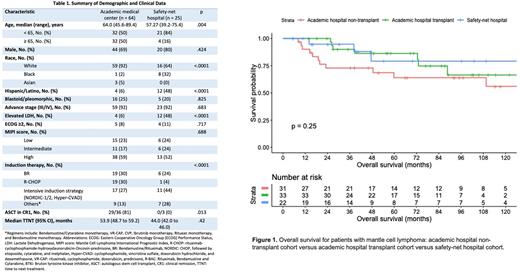Abstract
Background
Mantle cell lymphoma (MCL), a rare, aggressive lymphoid malignancy, accounts for 5-10% of non-Hodgkin lymphomas. Studies have recognized first-line autologous hematopoietic stem cell transplantation (ASCT) as a potential consolidative therapy in MCL for medically fit patients achieving complete remission following induction chemoimmunotherapy. However, treatment practices vary widely across institutions especially with the advent of novel targeted and cellular therapies. Safety-net hospitals have limitations in patients' access to treatment options like ASCT due to insurance barriers and treatment funding. This study analyzes the demographics, treatment patterns, and survival outcomes among MCL patients treated at a public safety-net hospital versus a private tertiary academic institution within the same healthcare system. The primary aim of the study was to analyze the utilization and impact of consolidative ASCT on survival outcomes in MCL patients.
Methodology
We conducted an IRB approved, retrospective review of 89 patients diagnosed with MCL who were treated within our healthcare system between January 2009 and December 2020. Primary variables analyzed include comparison of demographics, disease characteristics, chemo-based induction modalities, and survival outcomes. Hypothesis testing was performed using chi-square tests, t-tests, and other nonparametric tests as required, with a 2-tailed P value ≤ .05. Survival analysis for progression-free (PFS) and overall survival (OS) was performed with the Kaplan-Meier methodology and evaluated with the log rank test. Univariate and multivariate hazard regression was used to assess the relationship between pre-specified variables and primary endpoint of OS, and secondary endpoints of PFS, and time to next treatment (TTNT).
Results
Among the 89 patients with MCL, 25 (38%) were treated in a safety-net public hospital, whereas 64 (72%) were treated at a private academic center. Baseline characteristics are shown in Table 1. Significantly higher proportions of patients treated at the safety-net hospital were younger than 65 years (p = .004), African American (p<.0001), or Hispanic/Latino (p< .0001) compared to those treated at the academic institution. Thirty-six (41%) patients underwent consolidative ASCT, 29 (81%) in first complete remission (CR1). There were no significant differences in OS and PFS by the treating institution (p = .863 and p = .787, respectively) (Figure 1), ASCT status (p = .438 and p = .264, respectively), or use of maintenance Rituxan (p = .390 and p = .792, respectively). On multivariate analysis, there was no significant association between ASCT in CR1 and OS (HR 1.37; 95% CI, 0.38 to 4.93; p = .63), PFS (HR 0.40; 95% CI, 0.14 to 1.20; p = .10), or TTNT (HR 0.76; 95% CI, 0.29 to 2.01; p = .58).
Conclusions:
In this 'real world' analysis, first-line consolidative ASCT in CR1 for patients with MCL did not demonstrate an improvement in survival outcomes. Patients treated at the safety-net hospital had comparable outcomes to those treated at the tertiary academic hospital. These findings are likely multifactorial due to disease and patient heterogeneity, multidisciplinary standardized treatment practices at both sites, and novel therapeutics contributing to improved safety-net hospital outcomes. This study is limited by its small sample size and retrospective design. Prospective research evaluating the utility of consolidative ASCT in MCL has the potential to personalize treatment paradigms in this unique disease.
Disclosures
Anderson:Amgen: Honoraria, Membership on an entity's Board of Directors or advisory committees; GSK: Honoraria, Membership on an entity's Board of Directors or advisory committees; Sanofi: Honoraria, Membership on an entity's Board of Directors or advisory committees; Beigene: Honoraria, Membership on an entity's Board of Directors or advisory committees; Bristol Myers Squibb: Honoraria, Membership on an entity's Board of Directors or advisory committees; Prothena: Honoraria, Membership on an entity's Board of Directors or advisory committees; Celgene: Honoraria, Membership on an entity's Board of Directors or advisory committees; Pharmacyclics: Honoraria, Membership on an entity's Board of Directors or advisory committees; AbbVie: Honoraria, Membership on an entity's Board of Directors or advisory committees; Janssen: Honoraria, Membership on an entity's Board of Directors or advisory committees; Karyopharm: Honoraria, Membership on an entity's Board of Directors or advisory committees. Kaur:UT Southwestern: Consultancy, Current Employment. Madanat:BluePrint Medicines, GERON, OncLiv: Consultancy, Honoraria; Sierra Oncology, Stemline Therapeutics and Novartis: Membership on an entity's Board of Directors or advisory committees. Awan:Cardinal Health: Consultancy; BMS: Consultancy; ADCT Therapeutics: Consultancy; Epizyme: Consultancy; Merck: Consultancy; Caribou Biosciences: Consultancy; Cellecter Bisosciences: Consultancy; Dava Oncology: Consultancy; Johnson and Johnson: Consultancy; BeiGene: Consultancy; Incyte: Consultancy; Verastem: Consultancy; MEI Pharma: Consultancy; Karyopharm: Consultancy; Celgene: Consultancy; Kite Pharma: Consultancy; Gilead Sciences: Consultancy; Pharmacyclics: Consultancy, Research Funding; Janssen: Consultancy; AbbVie: Consultancy; AstraZeneca: Consultancy; Genentech: Consultancy. Ramakrishnan:Kite: Consultancy; BMS: Consultancy; Rafael Pharma: Consultancy; Pharmacyclics LLC: Membership on an entity's Board of Directors or advisory committees; ADC Therapeutics: Membership on an entity's Board of Directors or advisory committees; Cellectar Biosciences: Membership on an entity's Board of Directors or advisory committees.
Author notes
Asterisk with author names denotes non-ASH members.


This feature is available to Subscribers Only
Sign In or Create an Account Close Modal